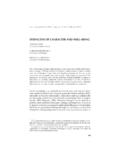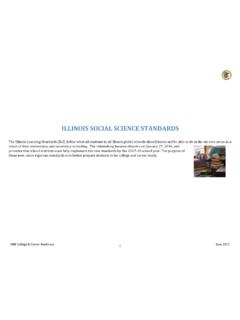Transcription of The Mirror and the Mask—On Narcissism and …
1 (1983) Contemp. Psychoanal., 19:359-387 The Mirror and the Mask On Narcissism and Psychoanalytic Growth1 Philip M. Bromberg, IntroductionTRYING TO EXTRACT SOME COHERENT view of Narcissism from the ongoing controversy in the currentpsychoanalytic literature is somewhat like trying to chill Russian vodka by adding ice cubes; it is possible to do it,but the soul of the experience is diluted. Levenson's (1978, p. 16) suggestion that "it may not be the truth arrived atas much as the manner of arriving at the truth which is the essence of therapy", leads me to wonder if it maylikewise be said that it is not the definition of Narcissism arrived at as much as the struggle to arrive at one, which isthe essence of recent progress in psychoanalytic thought.
2 The struggle contains within it, an emerging shift inperspective that has begun to influence our conceptions of clinical diagnosis, the nature of human development,psychoanalytic metatheory, and the parameters of psychoanalytic treatment the past two decades there has been a gradual but consistent movement of the mainstream ofpsychoanalysis in the direction of field theory, and toward the interpersonal context as the medium of both normalmaturation and therapeutic change (See Bromberg, 1979a). This has brought the developmental models ofpsychopathology and analytic technique into closer harmony than ever before, and has focused attention on thegrowth of "self" as inseparable from the interrelationship of "self and other", whether in the parental environment orthe therapeutic have been studying how the interpersonal field mediates the process by which self and objectrepresentations are born and internally structured; how inadequacy of interpersonal experience during variousphases of maturation can lead to structural pathology of the representational world itself.
3 How this structuralpathology can lead to specific forms of character disorders traditionally considered untreatable by psychoanalysis;and how a psychoanalytic relationship with such patients might indeed be possible from a field theory one outcome of this paradigm shift, the subject of Narcissism has become as currently fascinating andhumanly real as it has formerly been wooden and artificial. The metapsychological "puppet", like Pinocchio, hascome alive and gained a "self". In so doing it has become more interesting to psychoanalysts as an issue oftreatment approach and as a clinical data base supplementing hysteria, than as the original construct shaped byFreud (1914) to account for certain aspects of narcissistic personality has become accessible, as a live human being, to psychoanalytic treatment; but theCopyright 1983 Institute, New YorkAll rights of reproduction in any form Psychoanalysis, Vol.
4 19, No. 2 (1983)1 The central theme of this essay draws upon ideas from an earlier unpublished paper, Current psychological concepts of Narcissism ,presented May 1978 at a symposium chaired by Edgar Levenson, entitled Narcissism : Between The Mirror and The Mask, sponsored jointly bythe Brooklyn College School of Social Science, and The William Alanson White Psychoanalytic Institute. The author gratefully acknowledgesDr. Levenson's generosity in allowing him to borrow the conference incorporated here are aspects of an invited discussion (Bromberg, 1979c) of David Schecter's (1980) paper, Early Developmental Roots ofAnxiety, presented at The American Academy of Psychoanalysis, November " Narcissism " is now more vague and ambiguous as a hypothetical construct and as a nosological entity "thenarcissistic personality disorder".
5 It has in fact become almost a kind of operational watershed which is used todescribe those individuals whose object relations are characteristic of the developmental level of mentalrepresentation that Anna Freud (1969) calls "need satisfying", that Mahler (1972) describes as "magicalomnipotence", and that Immanuel Kant might consider a systematic violation of his categorical imperative;individuals who experience other people as a means to an end rather than as an end in themselves. The definingqualities are most often described in the psychoanalytic literature as a triad of vanity, exhibitionism, and arrogantingratitude, which for better or worse (Lasch, 1979, p. 33), is what the word " Narcissism " has come to mean inpopular (1977, p.)
6 209) describes what it feels like from behind the analyst's couch as ".. talking into the wind orwriting on the sand, only to have one's words effaced moments later by the waves. The patient either welcomes orresents the analyst's words (and) frequently does not even register the actual content. A session which seems tohave led to a certain understanding or experience of some kind may, 24 hours later, be totally forgotten."It is a quality of unrelatedness which represents the failure in development of a spontaneous, stable,taken-for-granted self experience. The individual tends not to feel himself at the center of his own life. He isprevented from full involvement in living because he is developmentally stuck between "the Mirror and themask" a reflected appraisal of himself, or a disguised search for one, through which the self finds or seeksaffirmation of its own significance.
7 Living becomes a process of controlling the environment and other people frombehind a mask. When successful it is exhilirating; when unsuccessful there is boredom, anxiety, resentment, andemptiness. But the critical fact is that an ongoing sense of full involvement in life is missing, often withoutawareness. The intrinsic experience of accomplishment is transformed into one of manipulation, exploitation, and avague feeling of fooling people. A state of well-being becomes the goal of living rather than its characteristicquality, and the moment to moment sense of being has little relevance other than as a preparation for the nextmoment. Existence becomes either a search or a waiting period for that moment not yet here when real life and truelove will begin .
8 The present is always imperfect in and of keeps the person going, and often able to manage the external appearance of a relatively well-functioninglife, is an internal structure referred to in the psychoanalytic literature as a "grandiose self" (Kernberg, 1975);(Kohut, 1971), (1972), (1977). Its main job is to be perfect (See Rothstein, 1980); that is, to achieve approbation, tonever be dependent, and to never feel lacking in any way. Although there is theoretical disagreement as to how this"grandiose self" is established, most analysts pretty much concur that it conceals beneath it a self image describedby Kernberg (1975) asa hungry, enraged, empty self, full of impotent anger at being frustrated, and fearful of a world which seems as hatefuland revengeful as the patient himself (p.)
9 233) .. The greatest fear of these patients is to be dependent on anybody elsebecause to depend means to hate, envy, and expose themselves to the danger of being exploited, mistreated, andfrustrated (p. 235).Consequently, any confrontation with this self image of perfection evokes an immediate need to protect it, andthe other person is typically greeted with either an increased dose of disdainful aloofness or with self-righteousrage. This often poses a bit of a problem for mates, lovers, employers, friends, and analysts, should they tend to be more than a "need-satisfying object".The picture I have been presenting is that of pathological Narcissism . Whether such a thing as "normal" Narcissism can be said to exist as a distinct entity is currently a controversial issue.
10 Ernest Becker (1973) haspresented a particularly compelling sociological position which examines and recasts the psychoanalytic theory ofneurosis in the context of man's need to cope with existential anxiety."In man", Becker states (pp. 3 6),a working level of Narcissism is inseparable from self-esteem, from a basic sense of self-worth .. it is all too absorbingand relentless to be an aberration; it expresses the heart of the creature: the desire to stand out, to be the one increation. When you combine natural Narcissism with the basic need for self-esteem, you create a creature who has tofeel himself an object of primary value: first in the universe, representing in himself all of , he says, is hopelessly absorbed with himself, and ".








